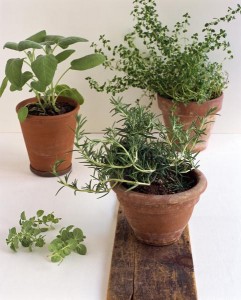The term “sustainable gardening” is a popular buzz term that sounds like something complicated and newfangled, but really just refers to the type of old-fashioned home gardening your parents or grandparents used to do. It would seem like all gardens are environmentally friendly, but growing the wrong plants for your area, depending on chemical fertilizers and pesticides to keep things growing and wasting gallons of water is anything but eco-friendly. A sustainable or environmentally friendly garden is one that can take care of itself; it means less work and less cost for you with more time to enjoy the benefits.
Reduce Water Use
“Food grows where water flows” is a saying often seen on billboards near farm country, and it’s true. But farmers on all scales can reduce their water use and still grow abundant crops – even if that crop is daisies or patio tomatoes. Using rain barrels or gray water systems to capture usable water is a great way to reduce the amount of fresh water it takes to keep your yard and garden growing. But careful site selection and native plants can go a long way to keep your garden sustainable from the start. By placing thirsty plants in cooler, shadier areas you’ll reduce the amount of water needed to keep them healthy. Native plants are those that grow naturally in your area; they’re perfectly suited for the growing zone and require little extra water, pruning or pest control.
Lose the Lawn
For most Americans, a lush green lawn is the sign of a well-groomed yard, but green lawns typically require a lot of chemicals, a lot of water and a lot of time to maintain them properly. Consider replacing your lawn with a low-growing drought-resistant herb like minus thyme, stepping stone thyme or Corsican mint. These are just three of several herbs that spread quickly, repel insects, can withstand foot traffic and never need mowing. If you can’t bear the thought of giving up a front lawn, synthetic grass may be your solution. Artificial grass is much more realistic than it once was and it’s easy to install. Plus, when you consider the cost of water, fertilizer and the time spent mowing, it’s even economical.
Feed the Wildlife
Pest management doesn’t have to mean using chemical pesticides. Pesticides can actually leave your lawn and garden more susceptible to disease because they get rid of the good bugs too. A garden with spiders, bees, butterflies, ladybugs, frogs, bats and birds is a healthy garden. Think about these little creatures when you’re selecting plants and choose the ones that will lure them into your yard by providing food and shelter. Shrubs with winter berries will keep birds in your yard, lavender, lamb’s ear and rosemary are just a few of the many plants that will attract bees and butterflies. A bat box placed high in a tree will give bats a safe place to rest while they rid your garden of gnats and other tiny flying pests and a few rocks piled in moist, shady corner might beckon a frog or two to come and eat the flies and beetles.
Letting nature work for you instead of working against it is what sustainable, environmentally friendly gardening is all about. By rethinking how and when you use water, which plants you grow and how you grow them, you can have one of the most enviable gardens on the block. And when the neighbors ask what your secret is, it’s OK if you don’t tell them the lawn is artificial – just tell them about native plants instead.
